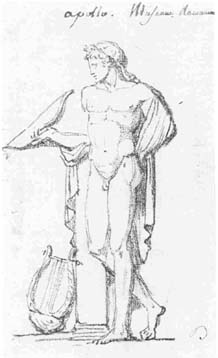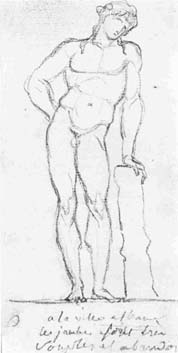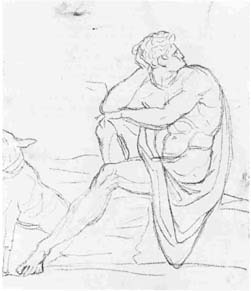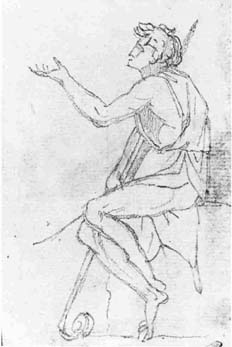
Annual Bulletin 7, 1983-1984
Home
Français
Introduction
History
Annual Index
Author &
Subject
Credits
Contact






The Shepherd Paris of
Jean-Germain Drouais
by John D. Bandiera
Pages 1
| 2 | 3
| 4
| 5
| 6
| 7
There is also great similarity in the diagonal compositions
of the four pictures and in the relationship of the figures to the surrounding
space. In every instance, space is compressed behind the figure and opened
up on the opposite side. This serves to isolate the figures (which occupy
a comparable amount of pictorial space relative to the whole) and to create
a meditative space around them. One can also point to the similarity of
mood; all the figures are pensive and withdrawn, and each picture conveys
a feeling of solemnity and seriousness.
To this long list must be added the similarity in the
illumination. For example, in all four works, brightly lit figures are
set off against darker backgrounds. Moreover, the cloudy and windswept
landscape in The Shepherd Paris resembles the landscape in the Philoctetes.
Similar as well are the metallic tones of the draperies in The Shepherd
Paris, the Dying Athlete, and Philoctetes. The brilliant red
drapery in The Shepherd Paris is also very close to the Prodigal
Son's drapery in The Return of the Prodigal Son and Marius' robe
in Marius at Minturnae.
Finally, the manner of painting is analogous in all four works. A close scrutiny
of the way the feet are painted in The
Shepherd Paris and the Philoctetes reveals their author's preference
for roseate tones and translucent white highlights on the toes. In both,
the skin seems thin and tightly stretched, with bluish veins discernible
beneath the surface.
The many parallels that can be drawn between The Shepherd
Paris and the three other unquestioned Drouais académies certainly
make an attribution to him more plausible. The case is strengthened by
a consideration of the Drouais Album, which contains over five hundred
unpublished drawings that he executed in Rome. (28) The Drouais Album,
which has a convincing provenance, was acquired in 1974 by the Musée
de Rennes. (29) It is a rich source of information about Drouais' early years
in Rome, what he saw, and what interested him. It also offers insight
into the artist's stylistic peculiarities. As such, it is central to this
discussion of The Shepherd Paris. From the Album we learn
of Drouais' interest in landscape; it contains almost one hundred landscape
studies, of which several (for example, fig. 5) are very close in spirit
to the background landscape of The Shepherd Paris. Other drawings
provide insights into such things as Drouais' characteristic manner
of treating draperies. In drawing number 186 (fig. 6) of the collection - a study of drapery
- the cloth is heavy, stiff, and 'metallic,' with angular
folds and broad flat planes alternating with areas of medium shadow. Once
again, this is very close to what may be seen in The Shepherd Paris,
as well as in other Drouais works such as Philoctetes and the Dying Athlete.
The wide range of subjects in the Drouais Album - copies after the antique, copies after Renaissance and Baroque masters,
landscapes, and so on - indicates that the present scholarly view
of Drouais' artistic temperament is much too narrow. In addition to the
studies of ancient sculpture, such as the Pergamene Group, which are stylistically
and expressively linked to the Dying Athlete and Marius at Minturnae,
others, comparable in style and spirit to The Shepherd Paris, show
Drouais' interest in a more serene and idealized classicism. In drawing
number 48 (fig. 7) of the Drouais Album, the figure of Apollo is
very similar to Paris in pose, with the left arm pulled back, the right
arm extended, and the legs crossed. The profile is also similar, as is
the position of the head. More provocative still is the treatment of the
torso and legs, with the musculature defined by soft shadows and the long,
smooth, and soft thighs. Similar qualities are evident in drawing number
34 (fig. 8), which also depicts an Apollo figure. This figure is particularly
close to The Shepherd Paris in the treatment of the legs - the thighs
are smooth and tubular, the knee on the front leg is delineated as a lozenge-shaped
area, and the calf of this same leg is a rather large angular protrusion
from the smooth bowed form of the shin. (30) With The Shepherd Paris,
the pectoral and stomach muscles are described with great economy,
and there is a graceful curve of the torso that terminates in a well-defined
pelvic ridge.
Here we see Drouais sketching works that have no connection with the severe world of Davidian neoclassicism of the 1780s.
In light
of this, it is not inconceivable that Drouais experimented in his painting
with a softer and less dramatic kind of academic nude, since many of the
drawings show his interest in figures of Apollo and the like. Nor is it
unlikely that he would have put his studies of figures of the Apollo type
to use in the execution of his académie. Nevertheless, The Shepherd Paris seems out of place in what Régis Michel has called, "l'univers dramatique qui révèlent les académies certifiées
de Drouais," (31) since it conveys none of the defiant/heroic spirit so evident
in the Dying Athlete and Marius at Minturnae. (32) An explanation,
however, can be found in the Drouais Album, which offers new insight
into the chronology of Drouais' first works in Rome.
Two drawings in particular indicate a palpable link between
The Shepherd Paris and the Rouen Seated Gladiator; both have
features that are common to both paintings. Drawing number 446 (fig. 9)
shows a seated figure with upturned head that is directly comparable to
the Rouen Seated Gladiator (especially the position of the legs). However, the presence of the dog suggests a connection with
The Shepherd
Paris. Drawing number 147 (fig. 10) also depicts a seated figure with
an upturned head, but here the figure holds a shepherd's staff and one
arm is extended (to receive the golden apple?). It seems likely, therefore,
that Drouais was drawing on the same group of studies for both académies.
But what does this tell us? One can only hypothesize.
One intriguing possibility is that The Shepherd Paris was the first
académie executed by Drouais in Rome, one that reflects his studies
of landscape and classical statuary. He decided not to show this work at
the annual exhibition in August 1785 because, in all likelihood, he wanted
to exhibit one that was closer to the letter and spirit of Davidian neoclassicism.
With time running out before the deadline, Drouais began the Rouen Seated
Gladiator, which is connected through drawings to The Shepherd
Paris and retains certain features, such as the smooth musculature
and semi-recumbent pose. The Rouen académie, with its 'heroic' elements
(laurels, sword, and helmet ), stone sarcophagus, and sombre cave-like
setting, is more severe than the Ottawa picture, but Drouais was still
not satisfied; with the deadline drawing near, he abandoned it. He then
began, and completed, the third académie in the series, the Dying
Athlete, a work that combines severity of form with archaeological exactitude
and a sharper expressive and moral focus. This image of fierce pride and
defiance in a severe Roman setting is a clear indication of the effect
on him of his collaboration on The Oath of the Horatii. (33) It is
also consistent with his growing disaffection from an academic establishment
that he felt was aligned against David and his revolutionary style.
Next Page | the Rouen picture
1
| 2 | 3
| 4
| 5
| 6
| 7
Annual Index | Author & Subject | Credits | Contact
This digital collection
was produced under contract to Canada's Digital Collections program,
Industry Canada.
"Digital
Collections Program, Copyright
© National Gallery of
Canada 2001"